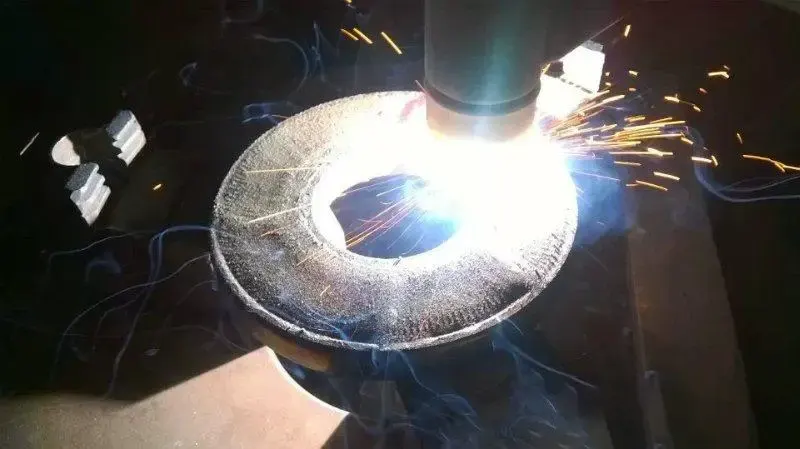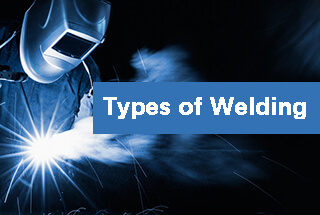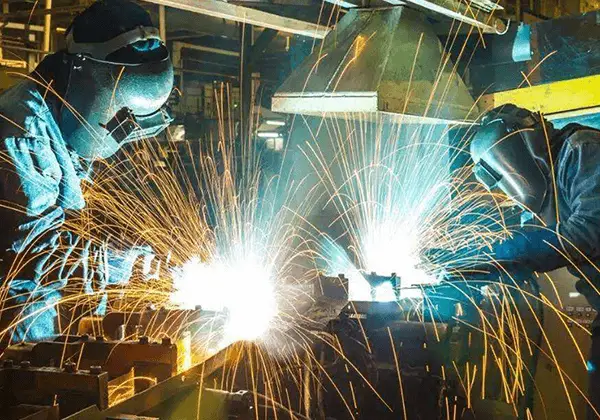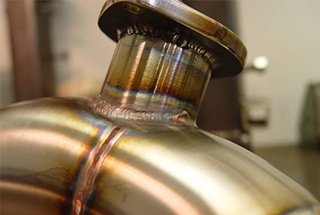Principle and development
Variable polarity plasma arc welding (VPPAW), namely asymmetric square wave AC plasma arc welding, is a new efficient welding process developed for aluminum and its alloys.
This welding technique combines the benefits of both variable polarity TIG welding and plasma arc welding. It allows for independent adjustment of key parameters such as current frequency, amplitude, and the ratio of positive and negative half-waveguide passing time to meet the specific requirements of the welding process.
This results in a more reasonable distribution of arc heat, minimizing the loss of the tungsten electrode and ensuring the weldment melts and automatically removes any oxide film on the surface. Additionally, the high energy density, velocity, and strong electric arc force of the plasma beam can effectively create a piercing molten pool, enabling single-sided and double-sided welding of aluminum alloy plates.

The variable polarity plasma arc welding technology is mainly used for the welding of various aluminum alloys.
The thickness of aluminum alloy that can be achieved in a single pass welding is 25.4mm.
VPPAW, or Variable Polarity Plasma Arc Welding, is known for its ability to independently adjust the amplitude of the positive current (DCEN), the amplitude of the reverse polarity current (DCEP), and the duration ratio of positive to reverse polarity current in each cycle. This feature contributes to both improved weld penetration and the removal of aluminum alloy oxide film.
In aluminum alloy welding, VPPAW employs the small hole upward vertical welding process, which not only aids in the formation of the weld at the front but also facilitates the release of hydrogen from the molten pool, thereby reducing the porosity defects in aluminum alloy. As a result, this method is referred to as the “zero defect welding” technique.

Fig. 1a: Welding diagram
- 1: Base metal;
- 2: Fusion weld metal;
- 3: Restraining arc nozzle
- 4: Shielding gas;
- 5: Coolant;
- 6: Isoionic gas
- 7: Welding wire;
- 8: Plasma arc perforation

Fig. 1b: Variable polarity waveform
Fig. 1 shows VPPA perforation vertical welding and common current waveform.
To decrease the wastage of the tungsten electrode, the reverse polarity current’s amplitude is greater than that of the positive polarity, with a positive to negative polarity pulse width ratio of approximately 19:4.
According to foreign studies, the amplitude and pulse width parameters for positive and negative polarities may vary slightly for different aluminum alloys, as demonstrated in Table 1.
Table 1: Welding parameters of various aluminum alloys (5mm plate thickness)
| Aluminum alloy materials | DCEN time/ms | DCEP time/ms | DCEN current/A | DCEP current/A |
| 5456 | 19 | 3 | 130 | 185 |
| 2219 | 19 | 3 | 140 | 180 |
| 5086 | 19 | 4 | 145 | 180 |
Advantages of VPPAW keyhole welding
There are two main plasma arc welding techniques: the penetration method and the keyhole method.
For thin weldments, the fusion method is commonly used, while for thick weldments, the small hole method is more often utilized.
When using the keyhole method, the plasma arc completely melts the weldment and creates a keyhole that penetrates the material under the force of plasma flow.
The molten metal is then forced around the keyhole.
As the plasma arc moves in the welding direction, the molten metal flows along the weld pool wall and solidifies on both the front and back, resulting in single-sided and double-sided welding.
Research conducted by the Boeing Company, Hobart Company, and NASA Marshall Space Flight Center has shown that keyhole plasma arc welding is the most effective method for welding aluminum alloys.
Compared to traditional TIG welding, the small hole VPPA welding technique has many advantageous qualities in the welding process.
1. There are few defects in the weld, such as air holes, slag inclusion, etc.
In the keyhole plasma arc welding process, the plasma arc and the ion gas flow through the keyhole play an important role in flushing.
In comparison with other welding methods, the plasma arc and ion gas flow through the keyhole remove any gas that would otherwise create pores in the molten metal and wash away slag inclusions.
Reiner knock discovered that when reverse polarity keyhole plasma arc welding of aluminum alloys was performed, porosity was significantly reduced compared to TIG welding. The welding effect on pure aluminum was even more pronounced, resulting in virtually no porosity.
Related reading: MIG vs TIG Welding
2. Wide range of weldable thickness.
The plasma arc boasts a potent ability to penetrate and is capable of welding aluminum alloys of 6mm thickness in various positions.
Research findings indicate that, for butt-welded flat plates with an unfilled welding wire, the maximum single-pass welding thickness is 8mm.
When welding thicker materials, the vertical welding method must be employed.
Single-pass penetration welding is permitted for aluminum alloys of less than 15.9mm in thickness.
Complex welding joints are often required for aluminum alloys thicker than 15.9mm.
Currently, 25.4mm-thick aluminum alloys can undergo single-pass penetration welding.
Presently, the maximum single-pass welding thickness does not seem to be limited by the welding method itself, but rather by the power of the welding power source.
By increasing the rated power of the welding power source, it becomes possible to weld thicker materials.
3. The weldment is small after welding.
The bending deformation of the weldment after welding is reduced due to the strong penetration ability of plasma arc welding, which results in concentrated heating and a small melting area, as well as uniform heating of both sides of the weldment through keyhole welding.
Compared to traditional welding methods, plasma arc welding significantly reduces the bending deformation of the weldment.
4. The mechanical properties of welds have been improved.
The yield strength of keyhole plasma arc welding seam is not significantly different from that of TIG welding seam after welding. However, if the root seam is removed and thickened, the yield strength of keyhole plasma arc welding seam is higher than that of TIG welding seam. This indicates that plasma arc welding has a higher quality than other arc welding methods, with improved mechanical properties and minimal weld deformation.
5. High efficiency and low cost.
Due to its high energy density and strong penetrability, plasma arc welding has a large weldable thickness. This makes it ideal for thick plate welding, as it reduces the number of weld passes and minimizes defects such as porosity and slag inclusions.
The resulting welded joints have minimal deformation, reducing the need for post-weld inspection and repair. Additionally, the groove can be used for joints and is less sensitive to oil contamination, requiring less preparation before welding.
Compared to TIG and MIG welding, plasma arc welding is both more efficient and cost-effective. It is a high-efficiency, low-cost welding method.
Deficiencies of VPPAW welding process for aluminum alloy
1. There are numerous variables in welding parameters with a narrow range of specifications.
2. The welding process used is the upward vertical welding method, which can only be performed automatically.
3. The quality of the weld is greatly impacted by the welding gun, and the nozzle has a limited lifespan.


